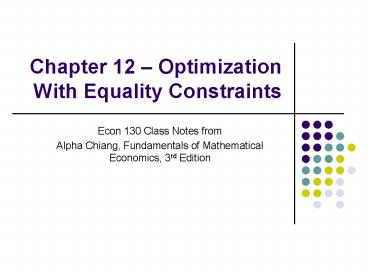Chapter 12 Optimization With Equality Constraints - PowerPoint PPT Presentation
1 / 23
Title:
Chapter 12 Optimization With Equality Constraints
Description:
The Bordered Hessian. Plain Hessian. Bordered Hessian: borders will be. Second ... Given a bordered Hessian. n-Variable Case: bordered principal minors are: ... – PowerPoint PPT presentation
Number of Views:811
Avg rating:3.0/5.0
Title: Chapter 12 Optimization With Equality Constraints
1
Chapter 12 Optimization With Equality
Constraints
- Econ 130 Class Notes from
- Alpha Chiang, Fundamentals of Mathematical
Economics, 3rd Edition
2
Introduction
- Previously, all choice variables were independent
of each other. - However if we are to observe the restriction
Q1Q2 1000, the independence between choice
variables is lost. - The new optimum satisfying the production quota
constitutes a constrained optimum.
3
Effects of a constraint
are positive for all positive levels of x1 and x2.
Budget constraint
Such renders x1 and x2 mutually
dependent. Problem How to maximize U subject
to the given constraint.
4
Lagrange Multiplier Method
The symbol ? is called a Lagrange multiplier. It
is treated as an additional variable
5
Lagrange Multiplier Method
In general
? measures the sensitivity of Z to changes in
the constraint
6
n-Variables Case
7
Multi-constraint case
Suppose there are two constraints
8
Second Order Conditions
For a constrained extremum of
subject to
Second order necessary and sufficient condition
revolves around the algebraic sign of the second
order differential evaluated at a stationary
point.
We shall be concerned with the sign definiteness
or semidefiniteness of
for those dx and dy values (not both zero)
satisfying the linear constraint
9
Second Order Conditions
10
The Bordered Hessian
- Plain Hessian
- Bordered Hessian borders will be
11
Second order condition
Determinantal Criterion for sign definiteness
min
max
12
Second order condition
Conclusion
13
Examples
Example 1. Find the extremum of
First, form the Lagrangian function
By Cramers rule or some other method, we can
find
14
Examples
Example 1. contd
15
Examples
Example 2. Find the extremum of
16
Examples
Example 2. contd
17
n-Variable Case
Objective function
subject to
with
Given a bordered Hessian
18
n-Variable Case
bordered principal minors are
.
with the last one being
19
n-Variable Case
.
20
Example Utility Maximization and Consumer Demand
21
(No Transcript)
22
Example Least cost combination of inputs
Minimize
subject to
First Order Condition
23
Second order condition
Therefore, since Hlt0, we have a minimum.































